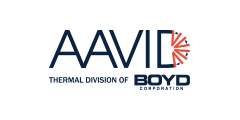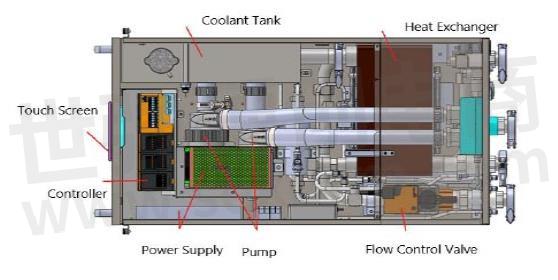What Is A Coolant Distribution Unit (CDU)?

A Coolant Distribution Unit (CDU) is a system that enables smaller, more efficient, more precise liquid cooling in a data center at Rack level, often integrating facility water. The CDU circulates the coolant in a closed-loop system within the rack on the secondary (Cooling Application) side and utilizes facility water on the primary (Heat Rejection) side. A CDU has a pump, reservoir, power supply, control board, and a heat-exchanger as the key components. Filters, flow meters, pressure transducers, and other devices are also used in managing the operation of the CDU in conjunction with the Server Rack.

CDU Schematic
Smaller, improved cooling with the design flexibility and customizations available for CDUs allows for data center operators to increase compute density by including additional racks. CDUs also provides the opportunity to rethink data center footprint configuration to maximize power density and energy efficiency.
When a server or chassis heat loads outpace what traditional air cooling can achieve, CDUs offer higher thermal performance in smaller packages. Negating the need for bulky heat sinks, fan trays, and components in air-cooled systems that create significant environmental noise pollution and consume more energy, integrated CDUs enable greater server power density with quieter operation and more efficient natural resource utilization.
Boyd CDUs are right-sized and custom configured for specific applications so that they receive the exact, optimal cooling performance the system needs when it needs it. Intelligent controllers with operation logic, automatic diagnostics and troubleshooting, protection and warning functions, as well as smart flow, pressure, and temperature controls manage system performance to spike with peak demand while remaining economical and efficient during non-peak operation and prevent problems before they occur. Blind mate quick disconnects with 360 swivel fittings make servicing systems fast for minimized maintenance downtime.
CDUs can integrate directly into facility water or facility-level cooling systems or can be designed as self-contained CDUs that offer a different level of flexibility. Cool the chassis, server or integrate CDU cooling capacity down to the processor or silicon. CDUs can be designed to integrate into the existing data center or chassis configurations to retrofit for improved efficiency. Boyd CDUs are designed to meet IEC62368-1 and tested to withstand 3X maximum working pressure. All new subcomponent designs undergo harsh maximum pressure testing to destruction. Reliability testing includes thermal cycling, min /max storage, and packaging testing to ensure long-lasting, high-quality, leak-free cooling.
Boyd has developed two key types of CDUs that are available based on size and implementation: In-Rack CDU and In-Row CDU.

In-Row CDU
In-Rack CDUs are designed to integrate into a server chassis and distribute coolant to a series of servers or heat sources. In-Rack CDU configurations are available for 2U - 5U sizes, installed within server chassis, and offer 60 - 80kW of cooling capacity. These feature redundant pump design, dynamic condensation-free control, automatic coolant replenishing, a bypass loop for stand-by operation, and automatic leak detection.

In-Rack CDU
Freestanding In-Row CDUs are larger and designed to manage high heat loads across a series of server chassis in data center environments. These full liquid cooling systems distribute coolant in and out of server chassis and can integrate into existing facility cooling systems or be designed to be fully self-contained. In-Row CDU capacity ranges start at 300 kW with models in development that cool up to 700kW.
BOYD CDU KEY FEATURES & BENEFITS
• REDUNDANCY
Increase reliability and enable continuous operation for less downtime and lower maintenance requirements through design redundancies such as multiple pumps utilizing N+1 configurations.
• HOT SWAP
Further, decrease downtime and enable continuous operation for a more efficient, higher producing facility by ensuring components such as pumps and cold plates can be swapped out or replaced while still hot, negating the need for cool downtime.
• COMMUNICATION PORTAL
Increase precision, monitoring, and control for greater efficiency with improved connectivity and control of the system through an advanced communication portal. Better data and monitoring to proactively scale or alter thermal systems for optimized application performance.
• WETTING CHEMISTRY
Leverage Boyd’s decades of experience in liquid-cooled systems that has resulted in a wealth of knowledge and innovation, including a deep understanding of wetting materials for the components in a liquid loop and how to best integrate technologies for fully optimized, highly reliable systems.
- +1 Like
- Add to Favorites
Recommend
- Designing Coolant Distribution Units (CDU) into Data Center Systems and Maintaining the Proper Operating Temperature
- Data Center Installations: In-Rack Cooling or In-Row Cooling?
- Nidec to Expand Its Production Capacity for Water-cooling Modules
- Coolant Distribution Units (CDUs) That Help Lower Data Center Total Cost of Ownership and Maximize Power Density
- Coolant Distribution Units - Improve Cooling and Performance of Cloud, Enterprise & 5G Applications
- Aavid‘s Liquid Cooling Systems: Modular or fully customized liquid cooling optimized for improved heat dissipation in condensed volumes
- Nidec Adds New Products including CDUs, Manifold Units and Pumps to its Lineup of Water-cooling Module
- Flow Types in Aavid Genie: Ducted Versus Bypass Flow
This document is provided by Sekorm Platform for VIP exclusive service. The copyright is owned by Sekorm. Without authorization, any medias, websites or individual are not allowed to reprint. When authorizing the reprint, the link of www.sekorm.com must be indicated.





























































































































































































































































































































































































































































































































































































































































































































































































































































































